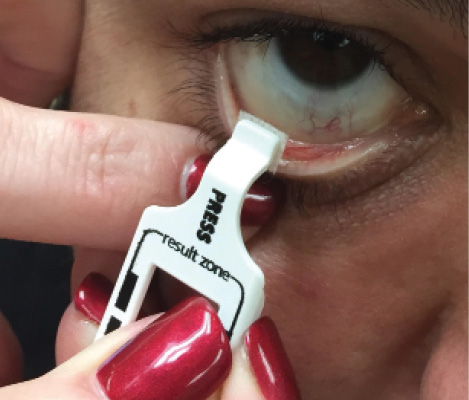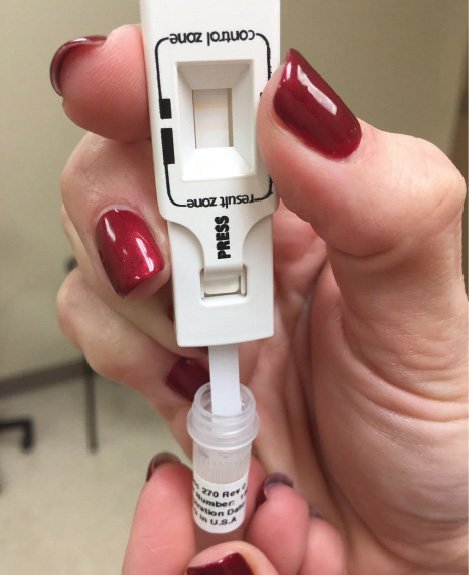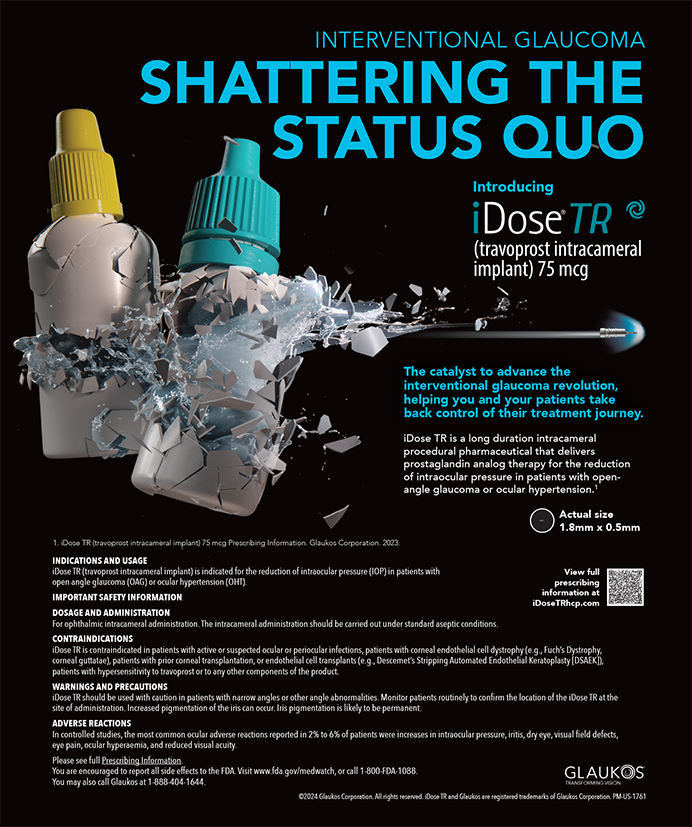
During the past decade, there has been a dramatic shift in the prioritization of dry eye disease (DED) by both physicians and industry. Once relegated to the lowest position among routine assessments, ocular surface disease (OSD) is now recognized as a chronic and progressive disease state. Ten years ago, doctors used the limited diagnostic options that were available, and little about the complex origins of DED was truly understood. Attention to this mercurial condition has increased thanks to several developments, including an evolution of diagnostic technologies, greater awareness of the potential refractive impact of DED, and a growing patient population.
THE DIAGNOSTIC PROCESS
Diagnostics are the key to accurately identifying the root cause or causes of a patient’s OSD. Without these tools, doctors tend to take a troubleshooting approach to treatment in which they try one option after another. Each failure disheartens both doctor and patient. Many DED patients have seen numerous doctors without success and are searching for someone to truly partner with them.
The first and most essential part of any ocular surface evaluation is the medical history. Careful acquisition of a detailed history not only directs the examination but also builds rapport with the patient. A comprehensive history allows the patient to identify therapeutic successes and failures and to recognize environmental triggers that may exacerbate the condition.
After the history, a complete DED evaluation often includes tear osmolarity, meibography, tear breakup time, aqueous volume, and other tests.
Elevated levels of matrix metalloproteinase 9 (MMP-9) are consistently found in patients with DED.1 InflammaDry (Rapid Pathogen Screening) is useful for identifying the presence of this marker in a tear sample taken from the palpebral conjunctiva (Figure 1). Within 10 minutes, the test provides results (Figure 2) with 85% sensitivity and 94% specificity (data on file with Rapid Pathogen Screening).
In my experience, InflammaDry is a particularly beneficial tool for diagnosing patients who report significant symptoms but who do not show corresponding clinical signs. A positive test identifies the presence of MMP-9, but it does not point to the specific origin. In our clinic, my colleagues and I initially used an Ocular Surface Disease Index (OSDI) score of 50 or greater to trigger the order for InflammaDry. Recent evidence suggests that MMP-9 does not necessarily correlate with symptoms, however, so critera will be broadening for use of the test.
DIRECTING TREATMENT
No flowchart can comprehensively direct the treatment of DED because of its multifactorial nature, but diagnostic testing can help to organize and narrow the differential diagnoses. Meibography, tear prism height, and aqueous volume measurements aid in determining if the patient has an aqueous-deficient, evaporative, or mixed form of OSD. This basic distinction can allow the doctor to initiate therapeutically effective treatments.

Figure 1. InflammaDry is useful for identifying the presence
of MMP-9 marker in a tear sample taken from the palpebral conjunctiva.
When tear insufficiency is suspected, punctal plugs can be a useful approach to therapy in select patients. If blepharitis or meibomian gland dysfunction is detected or suspected, treatment often begins with addressing any physical blockage of the meibomian glands and applying topical treatment for the inflammation. Intense pulsed light (IPL) therapy can also be a useful therapy in certain patients with meibomian gland disease.
PUNCTAL PLUGS
Punctal plugs were widely used a decade ago but became less popular when inflammation was found to play a causal role in a large number of DED cases. Bathing an inflamed eye in more tears seemed counterintuitive. Objective tests such as InflammaDry have been pivotal in identifying the presence of inflammation prior to treatment. The test can provide evidence that the eye is not inflamed, that therapies have resolved existing inflammation, or that inflammation persists, allowing the doctor to confidently choose whether to use punctal plugs.
Both absorbable and semipermanent plugs can be useful. It is often beneficial to start with an absorbable plug to see if the patient notes improvement. If symptoms are ameliorated, the insertion of a semipermanent silicone plug may be warranted. Additional considerations such as active infection or sensitivity to the material may exclude patients from the insertion of either type of plug.
The main advantage of an absorbable plug is that it is, by definition, not a permanent choice for the doctor or patient. The capricious nature of DED requires physicians to change their therapeutic recommendations over time. Remedies that work for months may not become part of a long-term regimen.
The Comfortear Lacrisolve 180 Absorbable Punctum Plug (Paragon BioTeck) is one way to achieve lasting, effective occlusion without a permanent commitment. Most temporary plugs dissolve or migrate in 90 days, but this product maintains its position for approximately 180 days. If the patient finds relief from these temporary plugs, then he or she may benefit from a semipermanent silicone plug.
IPL THERAPY
When conventional meibomitis treatments such as warm compresses and topical medications fail to bring relief, more advanced care becomes necessary. The efficacy of IPL therapy for the treatment of DED was serendipitously discovered in 2002 by Rolando Toyos, MD.2 IPL was originally recommended to diminish redness in patients with the dermatological signs of erythematotelangiectatic rosacea, but he found that patients with DED reported that the treatments decreased their symptoms as well.
Although the treatment’s mechanism of action is not well understood and warrants further study, preliminary results have been promising.2 The key advantages of the thermal effects of the xenon flashlamp are suspected to be objective improvements in meibomian gland secretions and tear breakup time, subjective improvement in the patient’s comfort, a decrease in the bacterial load at the eyelid margin, diminished lid telangiectasia, and an aesthetic improvement in the skin.
My colleagues and I use the M22 (Lumenis) in our practice to perform IPL. Many of my patients who experience success with IPL treatment have the evaporative form of DED, but I have also observed favorable outcomes in patients with aqueous-deficient DED associated with Sjögren syndrome. Certainly, patients diagnosed with rosacea who are experiencing DED symptoms are likely to be good candidates for IPL.

Figure 2. Within 10 minutes, the test provides results with
85% sensitivity and 94% specificity.
Specific inclusion and exclusion criteria must be strictly followed to ensure that patients achieve maximum benefit with minimum risk. A survey of skin type must be completed to determine the patient’s Fitzpatrick skin type. Skin types I, II, III, and IV are eligible with appropriate use of the filters available with the M22, provided there are no other contraindications. A test spot is recommended on the malar region where the skin is similar to the treatment area. A normal skin reaction will result in a slight pink/red flush that quickly fades. Patients must not take photosensitive medications such as doxycycline during the treatment course.
CASE STUDY
A 41-year-old Asian woman presented with a lengthy history of dry eyes. She had been placed on a regimen of cyclosporine ophthalmic emulsion 0.05% (Restasis; Allergan) twice daily several years ago, but she discontinued treatment after 1 month because she thought the drops were ineffective. The eye care provider she had visited most recently gave her lid hygiene products and artificial tears, but their use had not lessened the patient’s symptoms.
A thorough evaluation suggested aqueous deficiency. As part of the diagnostic battery, the patient underwent an InflammaDry test, and a positive result was recorded.
The patient was educated about the role of inflammation in her OSD. Loteprednol etabonate ophthalmic suspension 0.5% (Lotemax; Bausch + Lomb) twice daily and cyclosporine twice daily were prescribed.
One month later, not only had the patient’s OSDI score improved, but she also had a negative InflammaDry test result. The latter made an impact on her long-term prescribed medical therapy, which had previously been a barrier to success.
CONCLUSION
As new tools and technologies empower clinicians, it is fast becoming clear that OSD management simply is not one size fits all. Effective treatment requires a thorough, analytical understanding of the issue at hand; applying a broad treatment to every patient takes little time but ultimately benefits no one. A rigorous approach to diagnosis, using methods new and proven, ensures every patient receives the best care possible instead of the most expedient.
1. Chotikavanich S, de Paiva CS, Li de Q, et al. Production and activity of matrix metalloproteinase-9 on the ocular surface increase in dysfunctional tear syndrome. Invest Ophthalmol Vis Sci. 2009;50(7):3203-3209.
2. Toyos R, McGill W, Briscoe D. Intense pulsed light treatment for dry eye disease due to meibomian gland dysfunction; a 3-year retrospective study. Photomed Laser Surg. 2015;33(1):41-46.
Whitney Hauser, OD
• assistant professor at Southern College of Optometry, Memphis, Tennessee
• (901) 229-2137; whitneyhauser@sco.edu
• financial disclosure: board member for Paragon BioTeck and TearLab; speaker for and/or consultant to Akorn, Allergan, BioTissue, Lumenis, NovaBay, Science Based Health, Shire,
TearScience


